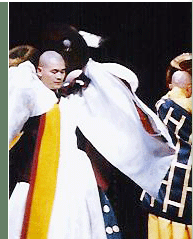|
 |
| Earlier it has been mentioned that Korean Pompae
was introduced by Jin-gam-guksa, the monk of Shilla who studied in
Tang of China. However, there are many evidences which show its earlier
arrival than Jin-gam-guksa's time. It seems very natural that Pompae
was introduced to Korean peninsula at the same time as Buddhism's
arrival. Its existence was traced at an ancient poem named 'Dosolga',
written by Wolmyeongsa, which appeared in [non-orthodox history of
Three Kingdom, written by Ilyeon, the monk]. Also Jagak-daesa Won-in(794-864),
Japanese monk, wrote in his book, [travelogue to Tang in search of
Buddha's words], that there was three kinds of Pompae, which were
Tang style, Shilla style, and Japanese ancient style (which introduced
to Japan through Korean peninsula before Tang dynasty), played in
Jeoksan. Thus, Pompae seemed to be played in Korean peninsula from
earlier times. Buddhism in Three Kingdom period flourished well enough
to leave its trace throughout many cultural heritage. In Koryeo dynasty
Buddhism thrived under the royal protection as a state religion. Kings
held Yeondeunghoe [lotus lantern ceremony] and set up Baekjwa-doryang
[hundred seated auditorium] in the palace. King Munjong held special
Yeondeunghoe [lotus lantern ceremony] for five days and nights at
Heungguksa, the temple, in January 1067. King Uijong(1147-1170), participated
in Yeondeunghoe [lotus lantern ceremony] at Bongeunsa, the temple,
with 16 chwigak-gunsa, the soldiers, standing on his both sides and
24 chwira-gunsa, the soldiers, standing his behind. From historical
evidences of frequent ceremonies it seemed that Pompae might have
been considerably popular in Koryeo dynasty. Pompae was on the decline
in Yi(Chosun) dynasty, when confucianism was a political ideology.
Still, the record shows that in August of 13th year of King Sejong(1431)
Pompae was played. There are some Pompae books such as [new revised
edition of Buddhist music] (1713), [patterns in Buddhist dance performance](1823),
written by Baekpa, the monk, and [tables and scores of buddhist music]
(1478). In 1748 (24th year of King Yeongjo) Daehui, the greatest master
in Pompae, wrote [collections of buddhist music]. According to the
fact that many names of Pompae monks appeared on [sector registry
of Buddhist music], Pompae was continued as a principal body of Korean
folk belief. In June 1911, under the rule of Japanese imperialism,
the ordinances on buddhist temples and the individual regulations
on main and peripheral temples were established. They prohibited Korean
monks from engaging in Pompae and Jakbeop. Also some buddhist ceremonies
became simplified. An Jinho, the monk, wrote [Models of buddhist ceremony]
in 1931, which covered a wide range of many buddhist ceremonies, and
it became a must book for the monks who were in charge of ceremonies.
After Korean Independence the buddhist worship ceremonies were on
the decline. However, the designation of Yeongsanjae as Intangible
Cultural Assets, no. 50, helped Beom-eum [Buddhist music], which has
been succeeded mainly in the region of Kyeongsang, Cholla, and Kyeonggi
provinces, to continue its legacy. |
|




